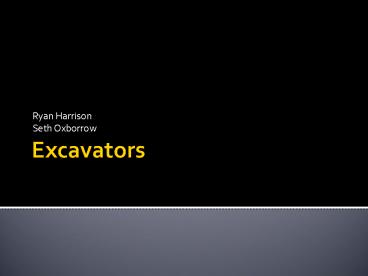Excavators - PowerPoint PPT Presentation
1 / 11
Title:
Excavators
Description:
Reach to depth of 6'-10' to 37'-11' (general purpose boom) Versatility: ... oil costs, tires (if wheeled excavator), hoses (due to the extensive use of hydraulics) ... – PowerPoint PPT presentation
Number of Views:5840
Avg rating:3.0/5.0
Title: Excavators
1
Excavators
- Ryan Harrison
- Seth Oxborrow
2
Brief History
- First appeared in late 1700s/early 1800s
- First patented steam shovel was by William Otis
in 1839 - Used extensively to build the Panama Canal
- Key in building Grand Central Station
- Electric Motors/Hydraulic Excavators first
introduced in 1930 - Gas-powered, modern Excavators
3
Unique Excavators
- Gradall Excavator
- Largest Excavator are over 200m long and 100m
high, they can excavate 100m long by 25m deep per
day
4
Other Excavators
- Front Shovel
- Backhoe
- Trackhoe
- Mini Excavators
- Ultra High Demolition Hydraulic Excavators
5
Typical Applications
- Digging of trenches, holes, foundations
- Material handling
- Brush cutting with hydraulic attachments
- Demolition
- General grading/landscaping
- Heavy lifting, e.g. lifting and placing of pipes
- Mining, especially, but not only open-pit mining
- River dredging
- Driving piles, in conjunction with a Pile Driver
6
Specifications
- General Components
- Wheels vs Tracks
- Boom
- Stick
- Bucket or other attachment
- Cab
- Counterweight
7
Specifications (cont.)
- Length from 12-1 to 53-2
- Height from 7-2 to 16-3
- Fuel tank capacity from 5.8 to 328 gal.
- Weight from 1.7 to 95 tons
- Reach to depth of 6-10 to 37-11 (general
purpose boom)
8
Versatility Available Attachments
- Versatility
- Mini Excavators offer greater maneuverability in
tight places but are limited in their reach - Larger excavators provide longer reach, but lack
the versatility - Can be used to lift or transport materials
- Attachments
- Augers
- Buckets
- Hydraulic Hammers
- Shears
- Thumbs
9
Advantages Disadvantages
- Advantages
- Excavates large quantities of dirt
- Wide variety of uses with different attachments
- Disadvantages
- Very operation specific
- Larger versions do not come with rubber tracks
- Larger versions are oversized loads
- Altitude issues with reduced radius excavators
- Serious weight issues (90-100 tons for higher end)
10
Buy vs Rent
- Areas to consider when buying
- Depreciation of the equipment
- Financing charges
- Insurance
- Overhaul
- Staffing (mechanics and operators)
- Warehousing/Storage costs
- Regular maintenance costs
- Renting eliminates many of these costs
- A careful evaluation of all costs should be taken
in each decision
11
Purchase Price Cost of Operation
Maintenance Costs These can vary considerably,
but things to consider are fuel and oil costs,
tires (if wheeled excavator), hoses (due to the
extensive use of hydraulics), and other operating
costs. Life Expectancy 6,000-8,000 hours before
the first major overhaul. Generally estimated
life expectancy of 10 years, although some have
been in use as long as 30 years.































